Todoist Review and History: A Deep Dive into the Simple To-Do List App for Getting Things Done
The task management software market has never been more saturated. Productivity enthusiasts can choose from hundreds of [to-do list apps](https://www.taskade.co...
The task management software market has never been more saturated. Productivity enthusiasts can choose from hundreds of to-do list apps, and there are still more popping up every day. In this Todoist review, we wind back the clock and analyze one of the oldest task management tools in the wild. Here’s the history of Todoist and its development.
📚 Before you start… Are you passionate about personal productivity? Do you want to uncover the origins of popular productivity apps and collaboration tools? Check these articles next:
💬 A Review of Slack, Glitch, and The History of Real-Time Communication
🪄 The History of Wunderlist: A Tribute to the Most Powerful To-Do List
🥚 The Early Days of Todoist (2007–2011)
The history of Todoist goes back all the way to 2007 and a computer science student Amir Salihefendić. A Bosnian national, Salihefendić emigrated to Denmark in the 90s when his family had to flee the war that erupted in Bosnia and Herzegovina.
The idea to build a task management app came shortly after Amir became a student at Aarhus University, one of the top 100 STEM universities in the world. The app he developed was meant to help him manage multiple jobs as well as his course work.
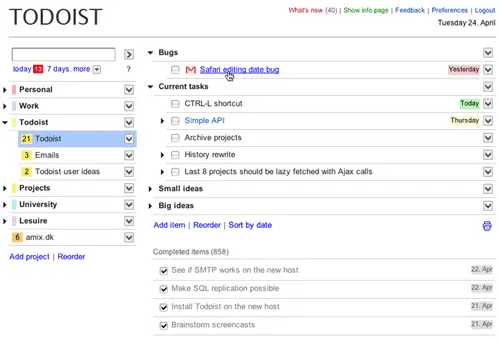
An early version of Todoist from 2007.
Image credit: Laughing Squid(1)
At some point, Salihefendić decided to spread the word about the new tool. That’s how Todoist was born. He managed to convert some readers of his blog into the first batch of users, and coverage from sites like Lifehacker and Digg helped bring first VC offers.
💬 “I actually very early on I got contacted by like some very famous VCs and they basically wanted to do a seed investment. I think it was like $500,000 or something—you know, for me that makes a few thousand dollars per month on this. Like, that’s a lot of money. And like one of the first suggestions he wanted to do is basically replace me as the CEO.“
—Amir Salihefendić in an interview with the Postlight Podcast(2)
Amir dropped out of Aarhus around 2007/2008 and took a co-founder’s position at an emerging social network Plurk. While Todoist’s user base grew, Salihefendić wasn’t interested in making Todoist a full-time project, so he kept moonlighting on the app.
💬 “So I didn’t really care that much, and I wasn’t very focused on it. Yeah, so basically, it was just a service I provided to people and I didn’t really care much about the growth or the numbers.”
—Amir Salihefendić in an interview with Baremetrics(3)
Salihefendić felt burned out and he eventually left Plurk around 2011. After quitting, he returned to Bosnia where his family lived at the time. The breakthrough moment came when Amir submitted an application to a seed accelerator Start-Up Chile.
🐣 From Doist to Todoist (2011)
Applying to a seed accelerator in Chile wasn’t high on Amir’s to-do list. He learned about the program from Hacker News and decided to try his luck with a random application email. He wasn’t interested in moving Todoist forward, so he submitted another app called Wedoist.
💬 “Before I went and worked full-time on Todoist, I actually tried to start something else called Wedoist, which is basically a live tool, project management tool. I did that for maybe six months, and I got like zero traction, then it was like, “What the fuck am I doing?”
—Amir Salihefendić in an interview with Salesflare(4)
In January 2011, Salihefendić got accepted to the program and received $40,000 of equity-free funding. He continued working on Wedoist for a few months, but the app was going nowhere. The reason? It was a “desktop-centric” tool in an increasingly mobile world.
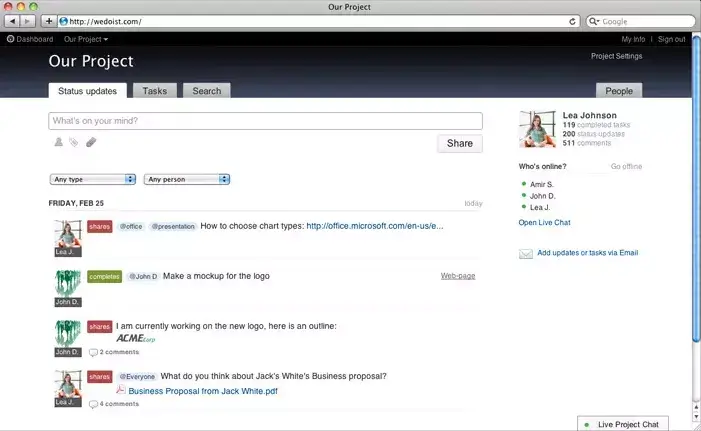
Wedoist user interface.
Image credit: AlternativeTo(5)
When Start-Up Chile wrapped up, Amir turned his attention back to Todoist. By that time, the app had grown in the background to 300,000 sign-ups. Salihefendić hired an outsourcing company in Romania to rebuild the app, but the results were far from satisfactory.
Thanks to connections he made through Start-Up Chile, Amir found developers in Portugal and hired them on a contract basis. Todoist didn’t have a solid business model, but its Premium subscription was making around $10,000, enough to start building native apps.
In March 2012, Amir founded Ist Productivity Ltd., a business that’d eventually become Doist, Todoist’s parent company. Several months later, Salihefendić decided to adopt a fully-remote model, mostly because it was easier to find talent beyond local markets.
✅ Doist, Systemist, and Co (2012–2016)
The official Todoist app launched in November 2012 for free with an option to upgrade. The whole idea for Todoist was based on a simple personal productivity system called “Systemist” Salihefendić created back in his university days.(6) The system consists of 6 principles:
✈️ Take it everywhere: Choose a portable tool to access/manage tasks wherever you go.
📥 Capture everything: Keep all tasks, notes, events, and insights in one place.
✅ Break it up: Divide big, complex tasks and projects into series of sub-tasks.
🚥 Prioritize: Not all tasks are created equal so learn how to prioritize effectively.
🗑 Achieve to-do list zero: Avoid leaving unfinished tasks on your to-do list.
🥳 Get feedback: Celebrate progress and reflect on your accomplishments.
On June 27, 2012, Todoist became the first HTML5-based task manager web application. Adopting a refreshed tech stack helped Todoist catch up with competitors. Some of the best Todoist alternatives at that time included Remember the Milk and Wunderlist.
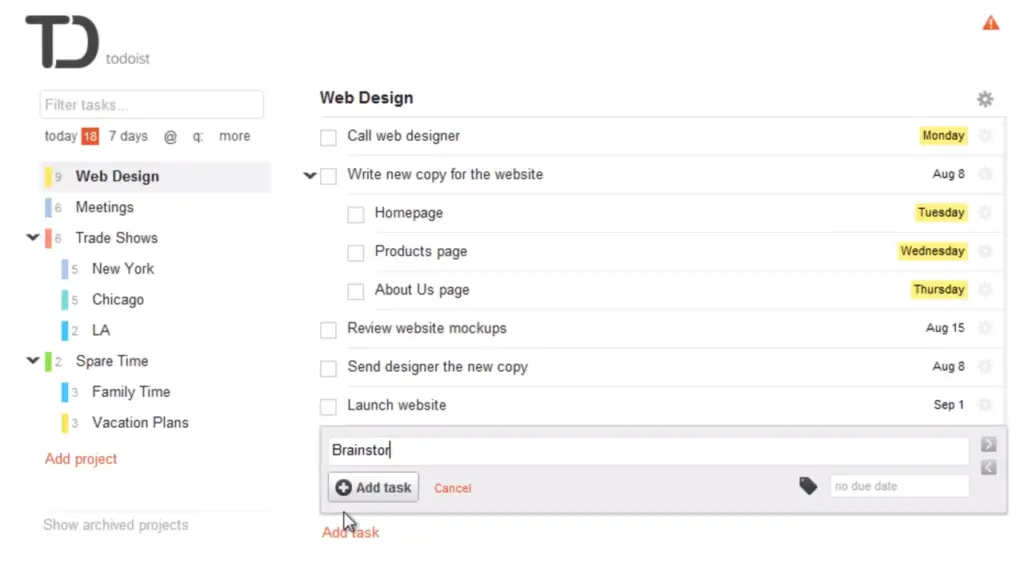
Todoist was rebuilt in 2012 using HTML5.
Image credit: TechCrunch(7)
In early 2013, Doist moved its HQ from Santiago, Chile to Porto, Portugal. The same year, the company rolled out “Todoist Karma,” a grading system and a centralized dashboard that provided users with rewards, tips, and productivity insights based on their activity.
In June, Todoist released Todoist Business which introduced several collaboration features and real-time synchronization. For $3 per user per month, business users could track up to 200 active tasks across 80 projects and manage teams in a centralized admin view.
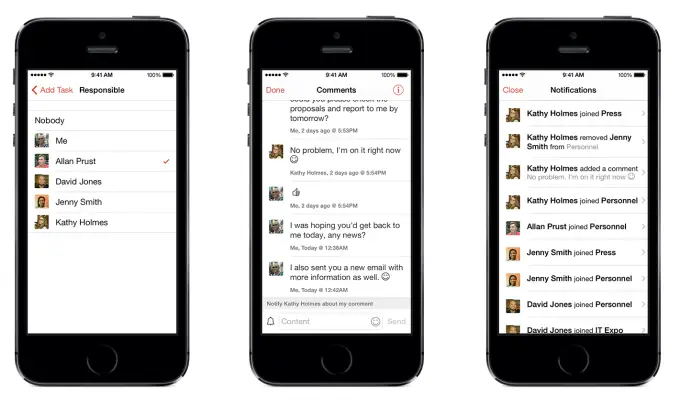
Todoist collaboration features on iOS.
Image credit: TechCrunch(8)
u
A year later, Todoist received more updates, including support for Android Wear devices. With over 2 million users and a snappy HTML-5 backend, Todoist was making a name for itself in the market full of competitors like TeuxDeux or Asana.
🎨 A Major Redesign and a Minor Slip-Up (2015)
On May 28, 2015, Todoist announced an Apple Watch app that had been four months in the making. The app allowed users to view tasks in two distinct ways—a Glance view for quick task previews and a Main view that displayed the Inbox, Projects, Todoist Filters, and Labels.
In September 2015, after a year of redesign work, Doist announced a revamped corporate image and brand identity for Todoist. The redesign included a new logo and typeset, an updated color scheme, and a redesigned website and blog to match.
The update added 10 customizable color themes, redesigned icons, improved responsiveness, and introduced changes to list rows. It also featured a natural language parser with 300 natural languages that powered an intelligent Quick Add function.
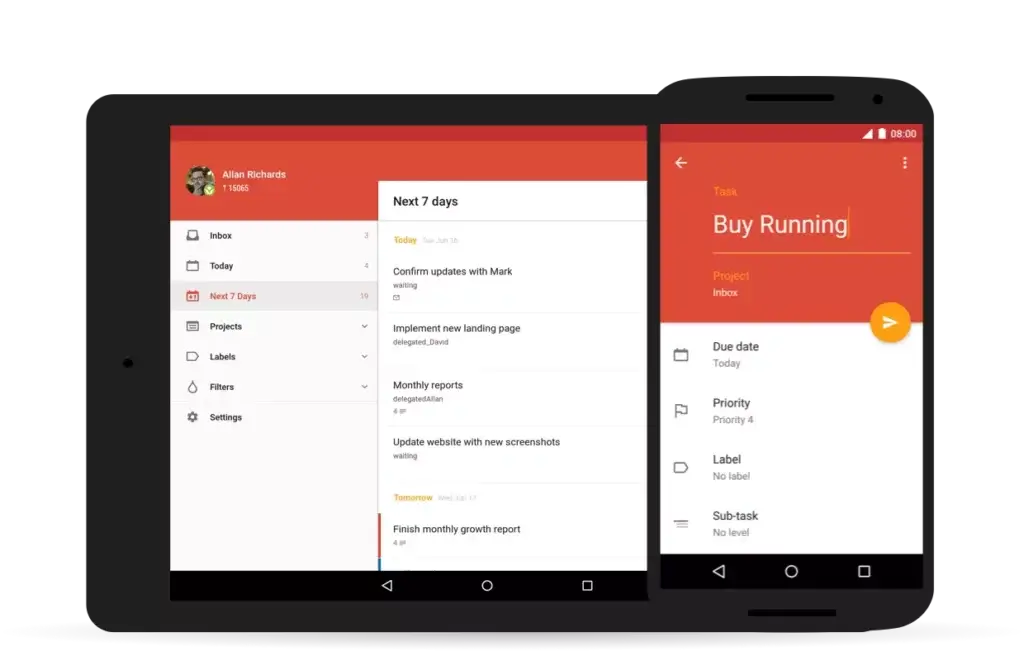
Todoist received a major redesign in 2015 that included an updated color scheme(9)
In November, Todoist launched a beta version of its new Windows 10 app. The company had set the stage for the release by acquiring a Windows Phone third-party client TaskCrunch developed by Jan Kratochvil. The app would leave beta in April the following year.
In March 2016, Todoist premiered the first version of its app with native Watch OS support. The release, however, was plagued by bugs and crashes which led to a slew of negative reviews on the App Store. The average score went down from 4.5 to 2.5 stars.
It took a while before the team managed to patch the app and get back on track with new releases. In November 2016, the app received another massive update which included an AI-powered task scheduler that analyzes user habits to determine task urgency.
👥 A New Twist on Asynchronous Communication (2017–)
The steady growth over the years allowed the company to diversify, and in 2014, Doist started developing an asynchronous communication app for remote teams.
The motivation? Salihefendić was fed up with the pressure of real-time communication Slack was imposing on remote-first companies like Todoist. Working across multiple zones wasn’t compatible with the expectation to stay connected 24/7.
Amir admits that the team initially built Twist for themselves according to Doist’s “build stuff for ourselves” product development philosophy. The competition was strong. On top of good ol’ email, the tool would have to compete with platforms like HipChat and Yammer.
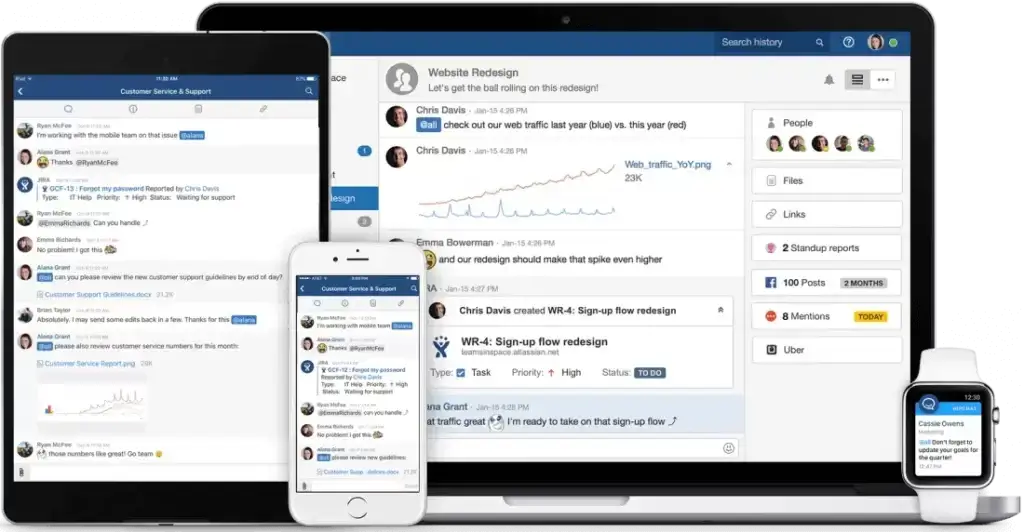
HipChat was one of Twist's competitors in 2017
The company ended up investing millions and five years of work into the new app. On June 22, 2017, Twist launched in an attempt to bridge the communication gap at remote-first companies. It was available for iOS, Android, Mac, and Windows at $5 per user/month.
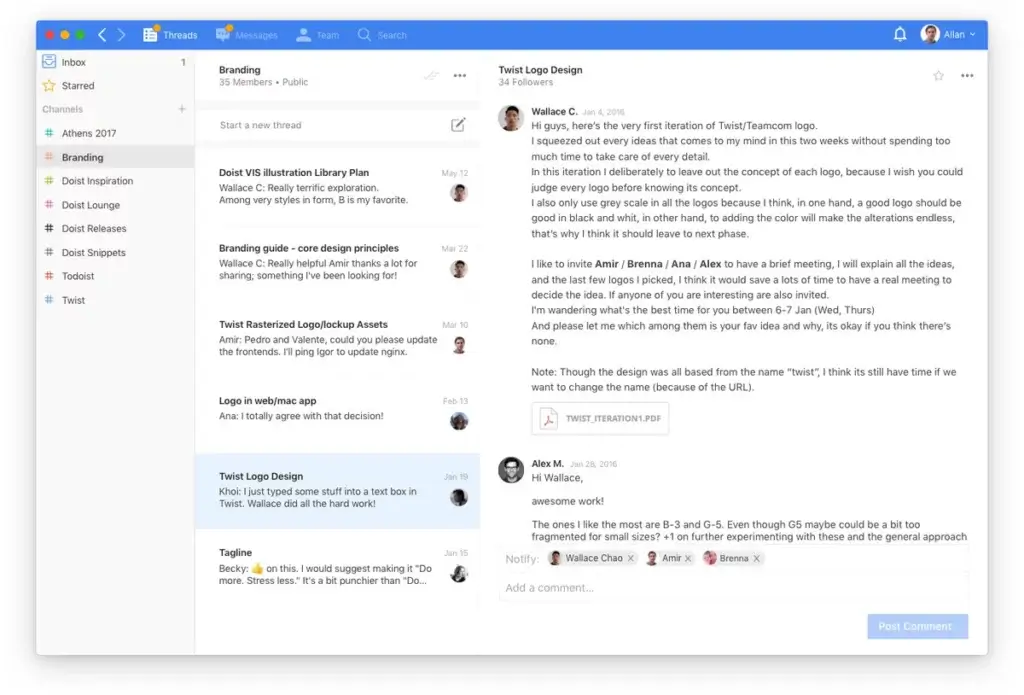
Twist is an asynchronous team communication tool(10)
Years after launching Twist, Amir would admit this wasn’t a path he would recommend or take again. Building another tool in such a saturated market was especially challenging because Doist did not take any VC funding and the platform struggled to become profitable.
In October 2021, Doist announced a Twist redesign that introduced new keyboard shortcuts and a cleaner look. In early 2022, the company had 73 employees spread across 25 countries, and in September of the same year, Todoist launched an official Linux release via Snapcraft.
👍 What Are the Major Pros of Todoist?
Todoist’s minimalist approach makes it an interesting proposition for anyone looking for a no-frills task management solution. The app offers a solid lineup of to-do features that should satisfy individual and business users, even if it’s somewhat limited in that last aspect.
Natural language processing (Taskade supports NLP with /slash commands!) and AI-backed task scheduling are two interesting features that make Todoist stand out from the crowd. Both make it much easier to add new tasks without having to fiddle with the UI.
Many users praise Todoist templates that make it much easier to kickstart new projects. The catalog includes ready-made frameworks suitable for students, freelancers, business owners, or anyone who wants to automate their workflow and avoid repetitive tasks.
Todoist cross-platform experience has also been one of the app’s highlights since it officially launched in 2011. Todoist has been pretty consistent in this regard and offers an even performance and feature set on Mac, Windows, Android, iOS, and in a web browser.
Finally, Linux support via Snap is a nice touch, especially now that the Linux scene has become more popular than ever. Empowering Linux users is a step in the right direction and something that we at Taskade also support with our Linux client.
👎 Is Paying For Todoist Worth It?
Todoist’s simplicity is also its biggest drawback. The app works as intended for basic task management, even in a professional setup. But managing more complex projects in Todoist is not the best idea, especially when they require team collaboration and planning.
The async-first philosophy makes Todoist a viable choice for teams who work across time zones with very little overlap time. But if your team relies on real-time communication, Todoist has nothing to offer in that regard, and Twist is only available as an extra integration.
Managing the time you spend on tasks is also not easy in Todoist. For instance, if you want to use the Pomodoro Technique as part of your workflow, you need to use more external integrations since Todoist doesn’t have a built-in countdown timer.
Finally, let’s talk about Todoist pricing plans. While there is a free tier, it’s limited to 5 active projects with 5 collaborators each. All that makes it difficult to use the free version of Todoist in larger teams, especially those that have to manage multiple projects at the same time.
👋 Conclusion
After 15 years on the to-do list app market, Todoist is still a popular choice among task management software. While the app does have a few shortcomings like limited collaboration features, you can still use it for personal to-dos and simple, small-scale business projects.
But...
If you want to get work done faster and smarter while collaborating with your team in real-time, try Taskade! 🐑 Taskade is an all-in-one productivity platform that lets you write, track to-do lists, manage projects, and chat/video conference in the same window, in the same app.
Here’s why Taskade is the best Todoist alternative! 👇
Manage all your tasks like a pro with Taskade AI! 🤖
🤖 Custom AI Agents: Overwhelmed with daily responsibilities? Set up a team of AI agents to automate routine tasks in the background.
🪄 AI Generator: Describe your project, and Taskade AI will generate a list of tasks to help you overcome any challenge, one check at a time.
✏️ AI Assistant: Generate documents, prioritize tasks, or break projects into subtasks right in the project editor using handy /AI commands.
🗂️ AI Prompt Templates Library: Taskade features hundreds of AI prompt templates for planning and executing all kinds of projects.
💬 AI Chat: Chat with Taskade AI to get suggestions on productivity, projects, and any other topic. It's like chatting with a colleague.
📄 Media Q&A: Upload your task lists, documents, spreadsheets, and other resources to get AI-powered insights and suggestions.
And much more...
What is Todoist used for?
You can use Todoist to manage tasks, keep track of personal obligations, and work on simple work projects. You can also collaborate with your team via a Twist integration.
What features does Todoist have?
Todoist packs many useful task management features like due dates, Todoist recurring tasks, filters, and reminders. It also includes some collaboration tools, but you need to use integrations to get access to more advanced options.
What are the major pros of Todoist?
Todoist is simple and flexible. The app’s minimalist UI design makes it a valuable proposition for users who don’t need a ton of extra features.
Can you write notes in Todoist?
No. While Todoist lets you add comments to tasks, the app isn’t designed for note-taking. You can use additional integrations that add the missing functionality.
Can I attach files to Todoist?
Yes. Todoist supports file uploads, but they’re limited to 5 MB in the free plan and 100 MB per file in the paid Pro and Business plans.
Does Todoist have an API?
Todoist uses REST API that allows developers to write apps and connect them to Todoist. There is also a Todoist Sync API for web and mobile apps.
